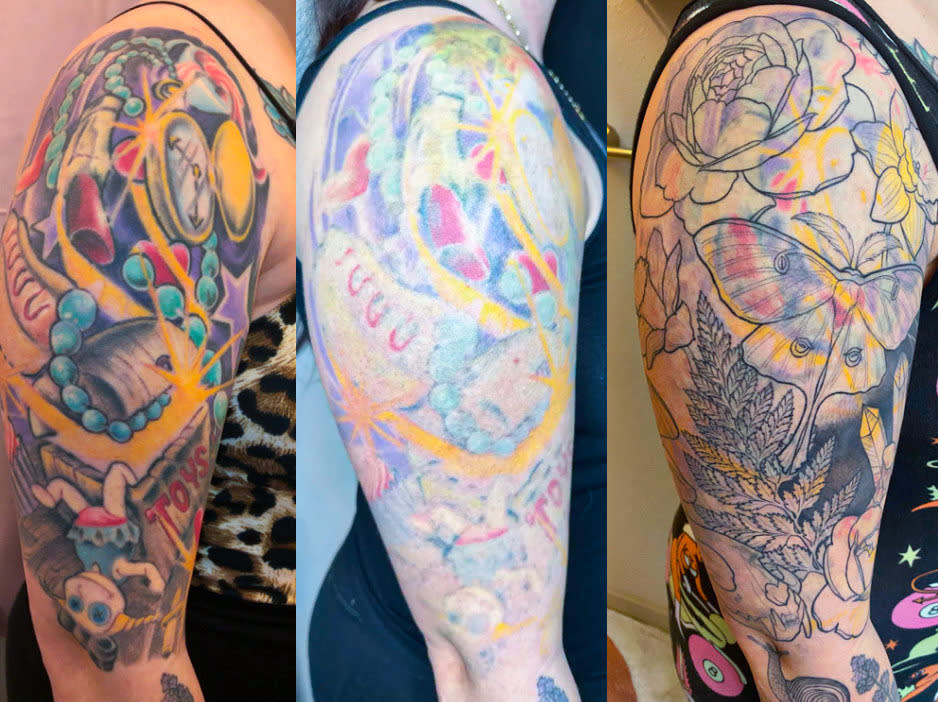And the Most Commonly Removed Tattoos in Portland Are...

Sarah Inloes at her East Burnside tattoo removal shop, Take It Off
Image: courtesy sarah inloes
Many people get a tattoo as a badge of pride. Sarah Inloes got one with the express purpose of having it removed.
As a tattoo removal specialist, she wanted first-hand expertise of her customers’ experiences. So she had her husband, a tattooer, buzz the name of her tattoo removal shop, Take it Off, onto her thigh. Then she spent the next two years lasering it off, letting it heal for eight weeks between a dozen sessions—yes, that’s how long the process takes. And those sessions start, for a postage stamp–sized tattoo, at $99 a pop; a tattoo the size of an 8.5-by-11-inch sheet of paper could easily cost $6,000 to remove, at $500 per session.

Inloes's "Take It Off" tattoo, before and after laser removal treatments
Image: courtesy sarah inloes
Inloes has no shortage of potential customers: The Pew Research Center reported in 2023 that 32 percent of Americans have at least one tattoo; nearly a quarter of those with tattoos said they had some regrets. By our math, that’s roughly 19 million US adults. Portland is continually ranked among the top 10 most tattooed cities in the US. And you might be surprised to learn that completely removing tattoos is the exception, not the norm.
Mostly, tattoos are instead substantially lightened, and Inloes’s work is often in collaboration with tattoo artists: perhaps the client wants to have their tribal armband covered with a Japanese dragon, and Inloes aims to set up the tattooer’s future cover-up. Or perhaps the customer wants to alter the shape or texture of microbladed cosmetics, like eyebrows and freckles. It’s more analogous to refinishing a hardwood floor than tearing it up.

Image: courtesy sarah inloes
“Let’s get to zappin'”
You may have seen a billboard around town of a gigantic tattoo being squeegeed off of a muscly dude’s back like soap off a windshield. It's a competitor's advertisement, and this couldn't be further from the reality of tattoo removal, Inloes says, both practically and metaphorically. “We’re not, like, baptizing you back into society,” she says.
Tattoos fade naturally on their own. Bodies constantly attack the foreign material, chipping off microscopic pieces of pigment. “We’re just speeding up the process,” Inloes says. Her laser breaks up tattoo pigment “boulders,” Inloes says, and “shatters them into smaller pieces.” The broken-up pigment then flows through your lymphatic system: meaning, she clarifies, “you pee, sweat, and poop out pigment.”
Variables that affect how removable a tattoo is include the wearer’s skin type, lifestyle, and the style and application of the tattoo. A tattoo is considered removed when 85 percent “clearance” is achieved. “If you’re sitting chair-to-chair with someone else,” Inloes says, “they wouldn’t be able to tell there’s any pigment there.”

In what's called a "blastover" tattoo, the black ink of an existing tattoo is lightened via laser, clearing space for a new design to "blast over" it, weaving the past with the present.
Image: courtesy sarah inloes
How to Choose a Tattoo You Might Still Love at 80
Among many other things, Inloes is an expert in regretted tattoos. She shared some of the most common designs she lasers off, many of which are trends that came and went:
- Mustache finger tattoos, which were popular among “hipsters” circa 2010
- Finger dots, which are similarly anachronistic
- Names of former partners
- Tattooed wedding bands
- Microbladed eyebrows and freckles, because styles change
- Lower back tattoos, colloquially known as “tramp stamps”
- Heavy, swirling tribal designs, popular among early-aughts reality stars
- Face and hand tattoos among early-to-mid-20s clients
- Watercolor-inspired tattoos with no black and “every single freaking color in the rainbow”
- Perfectly beautiful tattoos that the wearer wishes were in a different spot on their body
- Perfectly beautiful tattoos that hold bad memories for the wearer
Caveats: Inloes notes that lower back tattoos and tribal designs are coming back into style. She also says face and hand tattoos, once known as “job stoppers,” are less taboo these days, and is quick to defend well-considered tattoos in the same location. She sees her work not as cleaning the slate, but as an opportunity to help clients feel more comfortable in their “meat sack,” by better integrating existing tattoos with the client’s current self-image. “It’s honoring the past,” Inloes says, “but bringing something new to it.”




